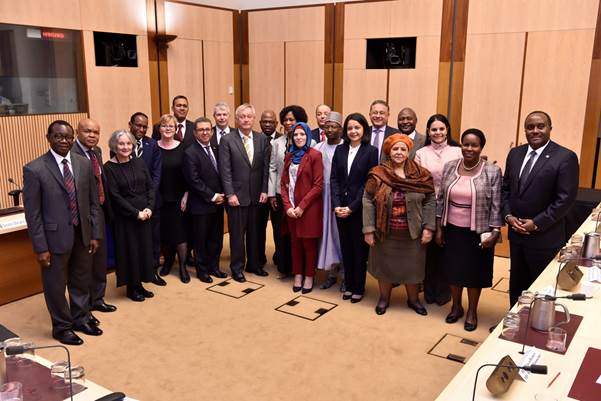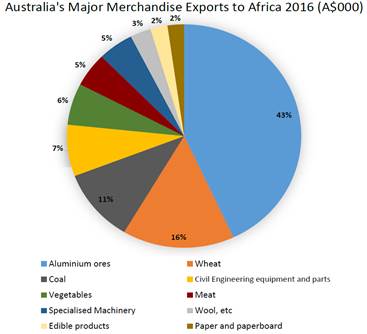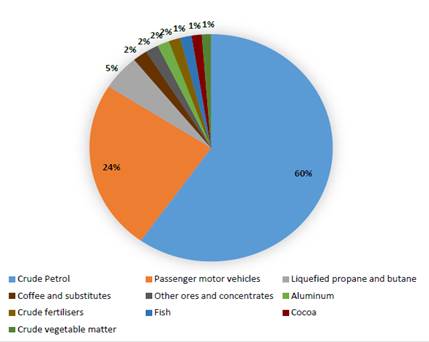Introduction
Referral
1.1
On 13 June 2016, the Senate referred the following matter to the Senate
Foreign Affairs, Defence and Trade References Committee for inquiry and report
by 14 February 2018:
Australia's trade and investment relationships with the
countries of Africa, with particular reference to:
- existing trade and
investment relationships;
- emerging and possible
future trends;
- barriers and
impediments to trade and investment;
- opportunities to
expand trade and investment;
- the role of
government in identifying opportunities and assisting Australian companies to
access existing and new markets;
- the role of
Australian based companies in sustainable development outcomes, and lessons
that can be applied to other developing nations;
- the role of
Australian based companies in promoting the achievement of Sustainable
Development Goals; and
- any related matters.[1]
1.2
On 27 November 2017 the Senate agreed to extend the reporting date to
27 April 2018.[2] On 26 March 2018 the Senate agreed a further extension to 21 June 2018.[3]
Conduct of the inquiry
1.3
Details of the inquiry were placed on the committee's website at: https://www.aph.gov.au/senate_fadt.
The committee also contacted a number of relevant individuals and organisations
to notify them of the inquiry and invite submissions by 18 August 2017. The
committee continued to receive submissions after the closing date. Submissions
received are listed at Appendix 1.
1.4
The committee held two public hearings for the inquiry: the first in
Perth on 2 May 2018 and the second in Canberra on
11 May 2018. A list of witnesses who gave evidence is available at
Appendix 3. Hansard transcripts of evidence may be accessed through the
committee website.
Acknowledgement
1.5
The committee thanks the organisations and individuals who participated
in the public hearings as well as those who made written submissions. The
committee would like to extend its particular thanks to the Heads of Mission of
the Africa Group for their joint submission and attendance at the committee's hearing
in Canberra on 11 May 2018.

Members of the committee with
the Heads of Mission of the Africa Group
Previous inquiries
1.6
In June 2011, the Joint Standing Committee on Foreign Affairs, Defence
and Trade tabled the report on its inquiry into Australia's relationship with
the countries of Africa which covered: government to government links;
Australia's aid program; education links; research links; trade and investment;
defence and security; and Africans in Australia.[4] The committee made 17 recommendations covering these areas, most of which were
agreed in the government response dated 22 March 2012. Those that were not
agreed included recommendation 10 (to establish a Centre for African Studies),
recommendation 12 (to expand e-visas across Africa), and recommendation 13 (to
undertake for Australia to become compliant with Extractive Industries
Transparency Initiative guidelines). Some matters were again raised during the current
inquiry and, where relevant, will be referred to in the report.
Structure of the report
1.7
This report is structured as follows:
- Chapter 1: introductory information about the inquiry and an
overview of Australia's existing trade and investment relationships with the
countries of Africa;
- Chapter 2: Australian mining in Africa;
-
Chapter 3: barriers to Australian trade and investment with the
countries of Africa; and barriers to African trade and investment in Australia;
- Chapter 4: broadening commercial interests beyond the extractive
industry as well as the promotion of commercial opportunities;
- Chapter 5: the government's role in increasing trade and investment
with Africa;
- Chapter 6: Australia's aid relationship with Africa, including
activities contributing to the achievement of sustainable development goals;
and
- Chapter 7: conclusion and recommendations.
Overview of Australia's existing trade and investment relationships with
the countries of Africa
1.8
The continent of Africa, second only to Asia in both landmass and
population, is diverse geographically, culturally, linguistically, and
economically. Comprising 54 sovereign states, nine territories, and two
de-facto independent states, Africa is home to over 1.2 billion people. This
number is increasing sharply, however, with African nations boasting some of
the youngest and most rapidly growing populations in the world.[5]
1.9
Submissions emphasised the importance of recognising that Africa cannot
be described or analysed as a single market but is comprised of discrete
economies with separate opportunities. For example, Grame Barty and Associates
stated:
When we talk about a trade and investment strategy we should
refer to significant, individual countries – such as Morocco, Ethiopia, South
Africa, Kenya, Nigeria, Ghana, or at least regions – North Africa, East Africa,
West Africa...Southern Africa. Each is different and it is important that we
unbundle it into its relevant parts. A conversation around genuine trade and
investment opportunities cannot occur until this transition by African
advocates is made. [6]
1.10
In its submission to the inquiry, the Department of Foreign Affairs and
Trade (DFAT) provided information on trade between Australia and individual
African economies. This data indicates that the goods trade with South Africa
is, by a wide margin, Australia's most valuable trade relationship with an
African country. In 2016, Australia's trade with South Africa was valued at over
$2 billion.[7]
1.11
Australia also maintains trade relationships with several other African
countries that, in 2016, were valued at over $100 million. These include
Algeria, Egypt, Gabon, Ghana, Mauritius, Mozambique, Nigeria, and Republic of
the Congo.[8]
1.12
As shown in Figure 1 below, Australia's major merchandise exports to
Africa, in 2016, were largely concentrated in the primary industries, with
aluminium ores, wheat, coal, vegetables, meat and wool all featuring in the top
10 exports. Civil engineering equipment and parts, and specialised machinery,
together formed 12 per cent of merchandise exports to Africa.[9]
Figure
1: Australia's major merchandise exports to Africa 2016 (A$000)

Source: DFAT, Submission 30, p. 15.
1.13
The top five export destinations for Australian goods to Africa in 2016
were:
- South Africa: aluminium ores; coal; machinery and parts.
- Egypt: vegetables; wheat; wool.
- Mozambique: aluminium ores; wheat.
- Nigeria: wheat; edible products.
- Ghana: civil engineering equipment and parts; machinery
and parts.[10]
1.14
As shown in Figure 2, Australia's major merchandise imports from Africa,
in 2016, were concentrated in crude petrol and passenger motor vehicles which
accounted for 84 per cent of imports.
Figure 2: Australia's major
merchandise imports from Africa 2016 (A$000)

Source: DFAT, Submission 30, p. 16.
1.15
The top five goods import sources from Africa in 2016 were:
- South Africa: passenger motor vehicles, ores and
concentrates.
- Gabon: crude petroleum.
- Algeria: crude petroleum.
- Republic of the Congo: crude petroleum.
- Equatorial Guinea: Liquefied propane & butane.[11]
Australia's trade with Africa,
state-by-state
1.16
DFAT's report, Australia's trade by state and territory 2016–17,
published in February 2018, noted that, on a state-by-state basis, Western
Australia has the greatest export trade relationship with Africa, with exports
valued at $1,389 million, and imports valued at $184 million in 2016-17. This
is followed by Victoria where the relationship is almost inverted, with $376 million
in exports and $1,369 million in imports over the same period. The trade
relationship between Queensland and economies in Africa is still relatively
small, with exports and imports valued at $417 million and $685 million
respectively. This period did, however, see significant growth in the bilateral
trade relationship between Queensland and Algeria predominantly as the result
of petroleum imports. Between 2014-15 and 2016-17, the value of imports from
Algeria to Queensland grew from $0 to $479 million, making Algeria Queensland's
17th largest source of imports. While Tasmania, as a small market,
does not command the same scale of trade as other states, South Africa is an
important trading partner with total trade of $39 million in 2016-17. This
makes South Africa Tasmania's 16th largest trading partner.[12]
1.17
Table 1 below shows the merchandise trade (imports and exports) with
Africa by jurisdiction for the 2014-15, 2015-16 and 2016-17 financial years.
Table 1: Merchandise trade to and from Africa by state and
territory
|
Jurisdiction
|
2014-15
|
2015-16
|
2016-17
|
|
Merchandise exports ($A million)
|
|
NSW
|
300
|
298
|
290
|
|
VIC
|
413
|
401
|
376
|
|
QLD
|
338
|
366
|
417
|
|
SA
|
439
|
315
|
276
|
|
WA
|
1,522
|
1,198
|
1,389
|
|
TAS
|
21
|
15
|
19
|
|
NT
|
2
|
1
|
0
|
|
ACT
|
0
|
0
|
0
|
|
Jurisdiction
|
2014-15
|
2015-16
|
2016-17
|
|
Merchandise imports ($A million)
|
|
NSW
|
650
|
523
|
531
|
|
VIC
|
1,516
|
979
|
1,369
|
|
QLD
|
608
|
382
|
685
|
|
SA
|
34
|
160
|
75
|
|
WA
|
458
|
231
|
184
|
|
TAS
|
29
|
12
|
35
|
|
NT
|
7
|
6
|
5
|
|
ACT
|
4
|
66
|
3
|
Source: Adapted from tables 13, 21, 29, 37, 45, 53, 61, 69 in
DFAT, Australia's Trade by State and Territory 2016-17, February 2018.[13]
1.18
DFAT's report also published data about the percentage share of
jurisdictional exports and imports from selected geographic regions as shown in
Table 2 below.
Table 2: Merchandise trade to and from selected geographic
regions by state and territory
|
Jurisdiction
|
Africa
|
Americas
|
Asia
|
Europe
|
Oceania & Antarctica
|
|
Merchandise exports (% share)
|
|
NSW
|
0.7
|
7.4
|
75.1
|
7.1
|
7.1
|
|
VIC
|
1.5
|
13.8
|
65.0
|
7.9
|
10.4
|
|
QLD
|
0.6
|
6.2
|
81.5
|
8.7
|
2.9
|
|
SA
|
2.4
|
14.1
|
67.3
|
11.6
|
4.5
|
|
WA
|
1.2
|
1.3
|
90.5
|
6.7
|
0.4
|
|
TAS
|
0.7
|
6.3
|
87.1
|
1.6
|
4.3
|
|
NT
|
0.0
|
3.7
|
93.3
|
1.9
|
0.1
|
|
ACT
|
0.0
|
0.0
|
3.0
|
97.0
|
0.0
|
|
Jurisdiction
|
Africa
|
Americas
|
Asia
|
Europe
|
Oceania & Antarctica
|
|
Merchandise imports (% share)
|
|
NSW
|
0.5
|
14.6
|
58.1
|
23.8
|
2.6
|
|
VIC
|
1.9
|
14.2
|
56.8
|
22.9
|
4.0
|
|
QLD
|
1.7
|
16.9
|
62.2
|
15.6
|
3.2
|
|
SA
|
0.9
|
15.8
|
62.5
|
18.3
|
2.3
|
|
WA
|
0.5
|
9.8
|
65.1
|
11.9
|
12.2
|
|
TAS
|
3.9
|
30.1
|
44.1
|
18.7
|
3.2
|
|
NT
|
0.3
|
11.5
|
67.9
|
18.4
|
0.2
|
|
ACT
|
0.0
|
29.8
|
10.3
|
51.1
|
7.8
|
Source: Adapted from tables 13, 21, 29, 37, 45, 53, 61, 69 in
DFAT, Australia's Trade by State and Territory 2016-17, February 2018.[14]
1.19
South Australia's trade relationship with Africa is relatively minor,
with African countries comprising just 2.4 per cent of merchandise exports, and
0.9 per cent of merchandise imports in 2016-17. In New South Wales, African
countries are 0.7 per cent of merchandise exports and 0.5 per cent of
merchandise imports.[15]
Navigation: Previous Page | Contents | Next Page